There’s something fishy about Christmas in the Czech Republic – namely carp. For those of you who cannot stomach this bony freshwater delicacy, there is something on the festive menu that’s guaranteed to get your taste buds going – vánoční cukroví. Those Czech Christmas cookies, which come in an impressive array of shapes and sizes, are so moreish that they’re practically impossible to resist – especially if they’re homemade.
I decided it was time to widen my baking repertoire by learning how to make the perfect cukroví. Expats.cz signed me up for patisserie chef Lucie Průšová’s intensive one-day baking course where along with three other cooking enthusiasts, I discovered the secrets behind three different kinds of Czech Christmas treat. As if that weren’t enough, we also kneaded and plaited the dough for our own vánočka – a festive fruit bread made from three braids of decreasing size placed one on top of the other. Check out the photos and this will all make sense, I promise.
Lucie, who has worked as a pastry chef in Michelin-starred Prague restaurant, Boheme Bourgeoise, has strong feelings about what makes great vánoční cukroví. In her view, if you want a quality product, you need to use the best possible ingredients. That means real butter rather than Hera, organic eggs and genuine chocolate rather than cheap chocolate coating. Sadly, she explains, many Czech bakeries skimp on ingredients to keep costs low – which is why it’s really worth dedicating time to making your own.
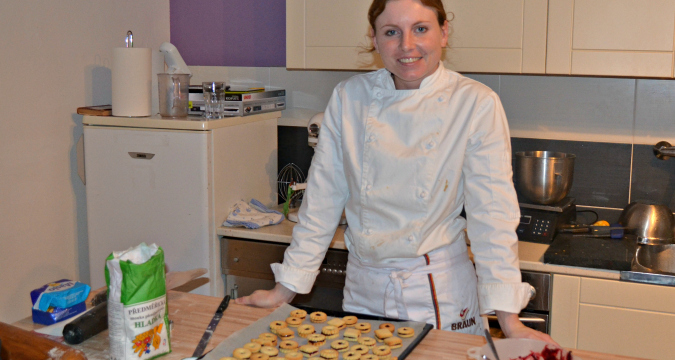
Pastry chef Lucie Průšová
Cukroví Sunday was one of the most demanding cookery classes I’ve ever attended. The pastry rolling action kicked off at 9am. We were on our feet until 5pm with just a short break for lunch. However, the results were delicious. My Czech partner even claimed that some of my cookies surpassed his mum’s in the taste stakes – the ultimate accolade. Sadly, I can’t share the sugary fruits of my labor with you all directly but here’s the next best thing: the recipes for cukroví so that you can go ahead and bake your own. Put your apron on, roll up your sleeves and get baking!
Vánočka (makes 4 small loaves)
1kg flour
10g yeast (dried is fine)
500ml scalded milk
200g caster sugar (krupicový cukr)
A pinch of salt
Zest of a lemon
350g butter
50g egg yolks (roughly 3) + one beaten egg, for glazing
100g flaked almonds
300g raisins
Wooden skewers
Add the sugar, butter and salt to scalded (i.e. just below boiling) milk. Stir until all the ingredients are combined then leave to stand until tepid.
In another bowl, sieve the flour then add the lemon zest, salt and yeast. Create a well in the centre, add the egg yolks, then gradually add the milk mixture until you have a firm, slightly elastic dough. If you have a food mixer, you can beat it with the paddle attachment until it is smooth; if not, you’ll need to rely on elbow grease!
Sprinkle a little flour on top then cover with a tea towel and leave in a warm place for at least two hours to give the dough time to rise.
Next, add the raisins and flaked almonds (reserve a few to sprinkle on later) and knead them in.
Divide the dough into four parts. From each of the four parts, you need to create nine sausage shaped pieces of dough, each about 30cm long, which you will plait together to create that special vánočka shape (see photos if you’re not sure what I mean). First of all, take four ‘strands’, join them together at one end by kneading them together a little at one end, then get plaiting! You need to take whichever strand is one the outside and lift it over the adjacent strand – this will make more sense if you actually try it out, I promise!
Once you have your foundation of plaited dough, glaze it with the beaten egg, and repeat the plaiting process with three strands. Place them on top of the first four, glaze, then take the remaining two dough strands, twist together, glaze and put them on the top. Use the wooden skewers to hold your fruit loaf together.
Bake in the oven for 40 minutes at 170°C. The vánočka should be quite dark in colour but not completely black obviously!
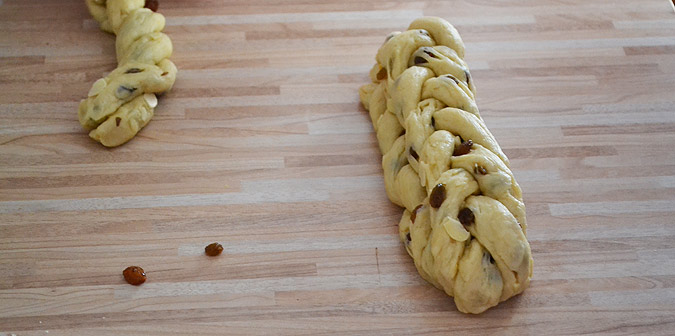
A traditional vánočka bread
Rohličky
The addition of grated coconut to these crescent-shaped cookies is a flavour twist that won the praise of my Czech other half – no mean feat!
400g plain flour (hladka mouka)
200g caster sugar
250g grated coconut
300g butter
50g egg yolks (approximately 3)
Grated star anise (badyán)
Mace (muškatový květ)
Vanilla pod
Icing sugar (for sprinkling)
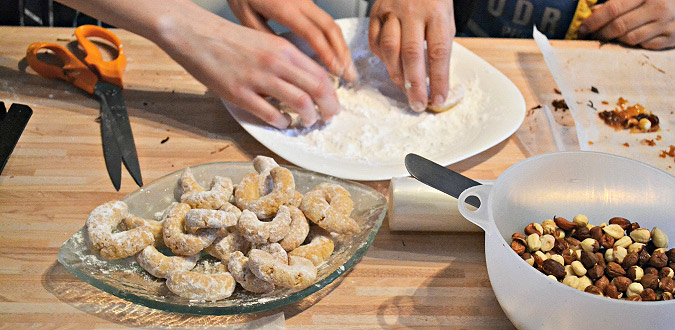
Crescent-shaped rohličky cookies
Place the flour and sugar in a pile on your work surface. Add the grated coconut to the mixture.
Make a well in the centre and add the butter in cubes along with the egg yolks. Knead together by hand until you have a dough. Lucie advises not using a mixer: this will take some time but be patient!
Make the dough into a cylinder (again, the consistency should be slightly elastic) then wrap it in a plastic bag and leave it in the fridge for 1–2 hours (ideally overnight) then let it sit at room temperature for 30 minutes before you begin handling it.
Now the fun starts. Lucie divided the mixture into around half a dozen cylinders then distributed them among us to be shaped into those little crescent moon shapes (see photo). We then placed them on a baking tray. Try to make sure your cookies are of a similar size or else the smaller ones will burn before the larger ones are ready.
Bake in the oven at 180°C for around 20 minutes. Once they’ve cooled, roll them in icing sugar and you’re done!
Linecké
When I think of cukroví, it’s these little classic cookies, decorated with melted chocolate and filled with jam, which always spring to mind. You’ll need a food mixer for this recipe – or alternatively, a willing helper with very strong arms!
250g butter
125g icing sugar
50g egg yolks (approximately 3)
250g ground almonds (mandlova mouka)
380g plain flour (hladke mouky)
Cinnamon
Nutmeg
Vanilla pod
Quality chocolate (dark or milk)
Jam of your choice (preferably homemade)
Take the flour, sugar, butter and egg yolks and beat them with a food mixer for around 15 minutes or until well combined. Then add the ground almonds, a pinch of cinnamon, nutmeg and the seeds from the vanilla pod. Knead together into a dough then place in a plastic bag in the fridge for at least one hour.
Leave out of the fridge for thirty minutes or so, then roll out the dough until it is 3–4 mm thick. Now the fun starts – using your favourite cukroví cookie cutters, cut the dough into shapes. Arrange on a baking tray lined with baking paper, put in a 180°C oven for 15 minutes.
Leave to cool, then sandwich together with melted chocolate or jam. Dribble melted chocolate across the top as decoration for that professional touch.
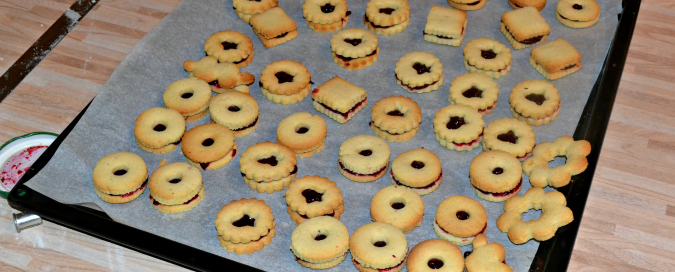
Classic jam-filled linecké
Florentines
Chewy, sticky and chocolatey, Florentines might not be all that Czech but they certainly are delicious – and pretty straightforward to make too.
300g caster sugar
350ml heavy cream (33% fat)
180g honey
Approximately 200 hazelnuts
350g dried and/or candied fruit (cranberries, apricots, raisins, candied orange or lemon – take your pick!)
100g plain flour
250g dark chocolate
Preheat the oven to 180°C.
Place the hazelnuts in the oven on a baking tray for about 10–15 minutes. The idea is to toast them so that the skins will peel off easily.
Combine the sugar and honey together in a bowl.
Put the cream in a pan on a low heat, then add the sugar, honey and flour. Heat gently, stirring constantly, until they melt.
Remove the hazelnuts from the oven and peel them.
Add the dried fruit and nuts to the mixture; stir until combined.
Line a baking tray with greaseproof paper then spoon on small dollops of the mixture. These should be no larger than a 20kč coin – they will spread a good deal when cooked. Try to space them at least 3cm apart so they don’t combine.
Bake in the oven for 12–15 minutes or until golden brown.
Melt the chocolate by suspending a heatproof bowl over a pan of boiling water.
Once the florentines have cooled, place generous dollops of the melted chocolate on another sheet of greaseproof paper. Press the florentines on top – do apply a fair amount of pressure so the chocolate spreads to cover the whole base – then set aside to cool and set.
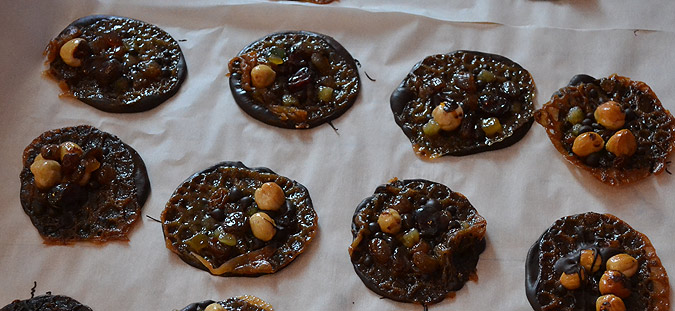
Chewy, chocolatey florentines
Lucie Průšová runs intensive cookery courses all year round on every aspect of patisserie from the finer points of cake decoration to baking French classics like mille-feuilles and macrons. Expect to receive a good deal of personal attention as class sizes are small and take place in Czech. You needn’t have top-notch linguistic skills to get the most out of the experience – a passion for creating in the kitchen is what’s really essential. For more details, go to her website.
**
Have you mastered the art of Czech baking? Share your tips and recipes here.
Related articles












 Reading time: 7 minutes
Reading time: 7 minutes 
































